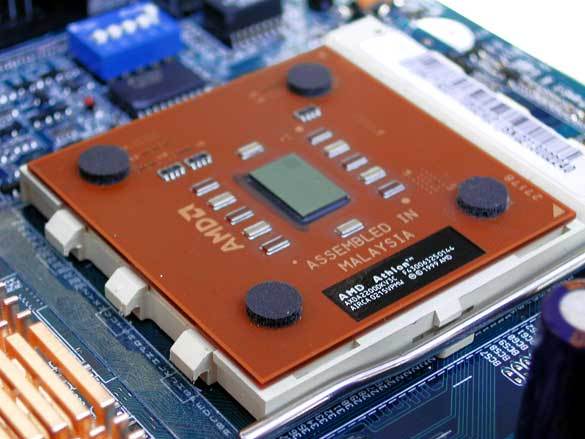A New Kind Of Fast: AMD Athlon XP 2200+
Conclusion: The Competition Bids Adieu
The eternal "AMD vs. Intel" competition has changed in character - what has previously been a close race is now no longer the case. Our comparison of the latest top model, the AMD Athlon XP 2200+, shows that the launch of the new Thoroughbred core, which involves a increased clock frequency, is not enough to attain the level of the fastest Intel Pentium 4/2533. Their respective performance in practice is reflected by the results of the 32 benchmark tests that we ran - the Athlon was only able to beat the P4 in two of the disciplines.
In the transition from Palomino to Thoroughbred, AMD reduced the structure from 0.18 µm to 0.13 µm and rearranged the units of the CPU at the same time. The goal is to pave the way for the new core, codenamed "Barton", which will soon be released. This will have a 512 kB L2 cache, and this is the only difference between it and the Thoroughbred.
Our extensive tests give the impression that the Athlon design is already a bit outdated and is now reaching its limits. We weren't able to overclock our sample of the Athlon XP 2200+ by a significant amount. In any case, the lab results were below that of the Athlon XP 2100+ (Palomino core) in our last test, which we were able to run stably at 1918 MHz. Also, it's no secret that the Athlon design is not meant for extremely high clock speeds as is the case for its arch rival, Intel's P4. However, the AMD Athlon XP is able to reach the same performance as that of a higher-clocked P4, which goes to show that clock speed alone is by no means an indication for performance. The strength of the Athlon still lies in the parallel execution of internal commands.
A further topic to consider has to do with the thermal protection of the new processors: with the launch of the Athlon XP with the Thoroughbred core, simultaneous to the launch of the new Athlon with the T-bred core, AMD has given new guidelines to the motherboard makers. Starting June 10, all motherboards must integrate thermal protection circuitry, which reacts to the temperature monitoring via thermal diode to switch off the power supply immediately. Otherwise, AMD will not take responsibility for a damaged CPU. The new thermal protection circuitry from AMD is a result of the video from the THG lab, which caused an uproar in the industry nine months ago.
There are also new recommendations for CPU coolers: since the new CPU die is significantly smaller, the heat dissipation of the top model (Athlon XP 2200+) is not any less than with the older Palomino, so a high-performance cooler is necessary. Here, the heat transfer between the CPU die and the cooler is decisive, because the heat has to be transferred over a very small surface of 80 mm. A few cooler manufacturers have responded to this and are already offering models with copper contact plating. A heat spreader, as used with the "Hammer", would have also helped to increase the contact surface to the cooler. In any case, cheap coolers have not lost out in modern Athlon XP systems! Basically, it's the same as with integrated thermal protection: if a processor dies a thermal death when used with an unapproved cooler, AMD will not take responsibility for it.
An important argument in favor of buying the processor is the price, but this can be looked at from two different perspectives: purchasing the CPU separately in a retail store, or purchasing a complete (OEM) system with the said CPU. The Athlon XP 2200+ costs $242 (per 1000 units), which is close to a third to the price of Intel's top model, the P4/2533. But if you look at the cost for a complete system, the difference is less marked. AMD still has a better price/performance ratio if you're less concerned with getting the absolute top performance. In this case, the true benchmark freaks will want to stick with a P4 system based on PC1066. The T-bred won't give you the a big performance boost, and we didn't expect it to, because ultimately, the CPU core has not been changed.
Still, it's going to be exciting, because the arrival of the Barton, with its larger L2 cache, is imminent. And VIA is working on the KT400 chipset, which is supposed to bring DDR 400 with 200 MHz to the Socket 462 platform. Thus, the race has not yet come to an end - the means are ultimately the goal!
Get Tom's Hardware's best news and in-depth reviews, straight to your inbox.
Current page: Conclusion: The Competition Bids Adieu
Prev Page 3D-Rendering: Cinema 4D XL 7.303